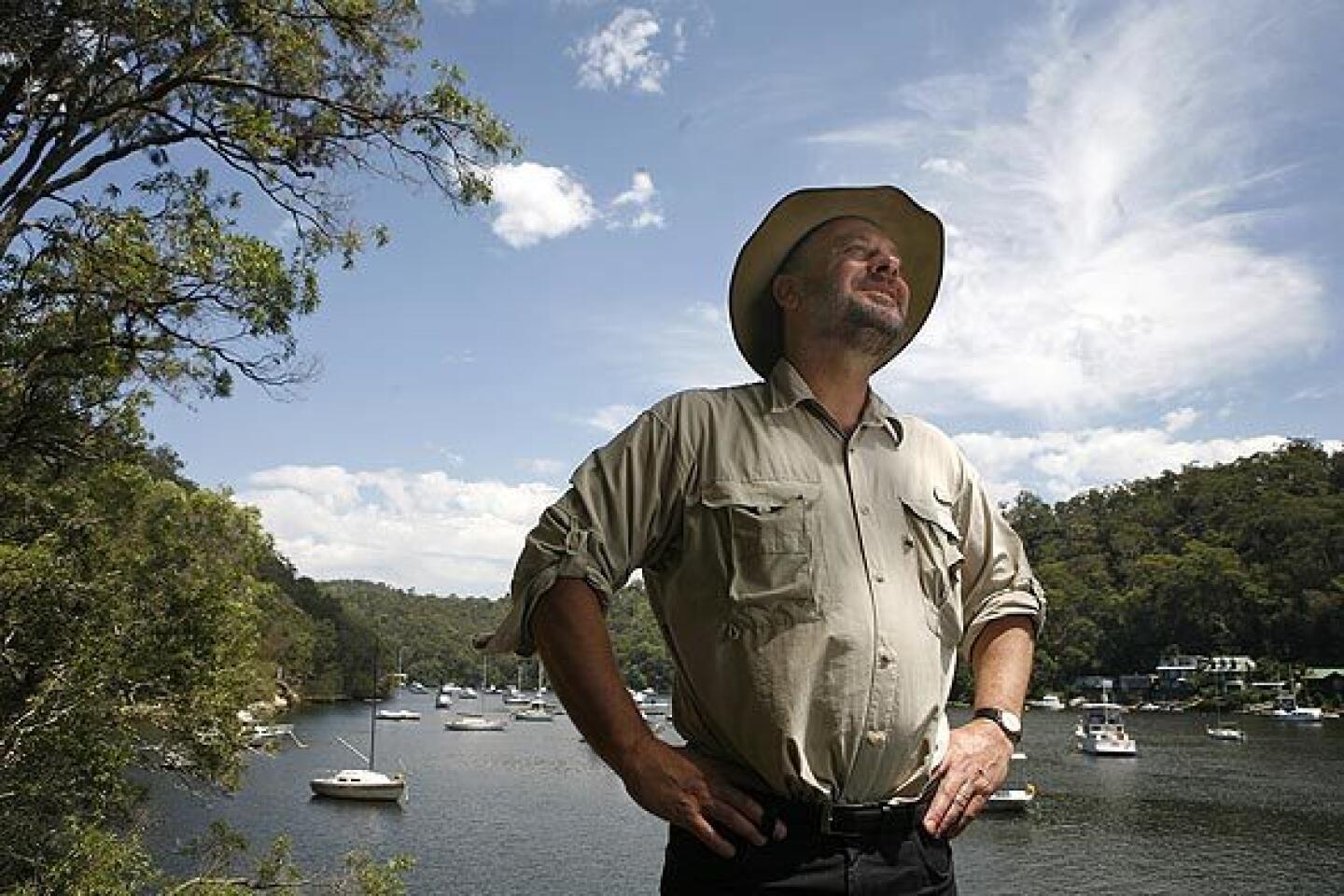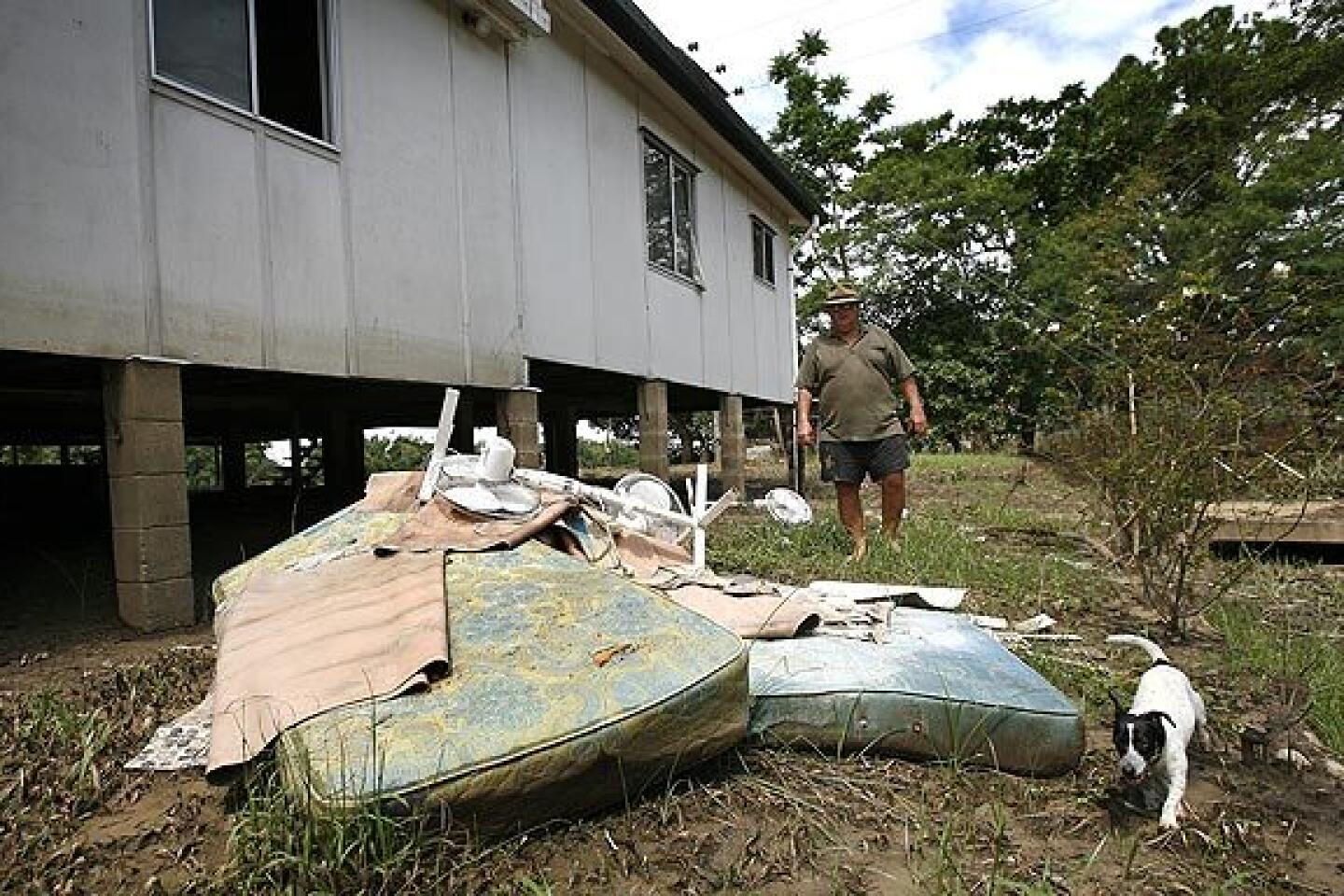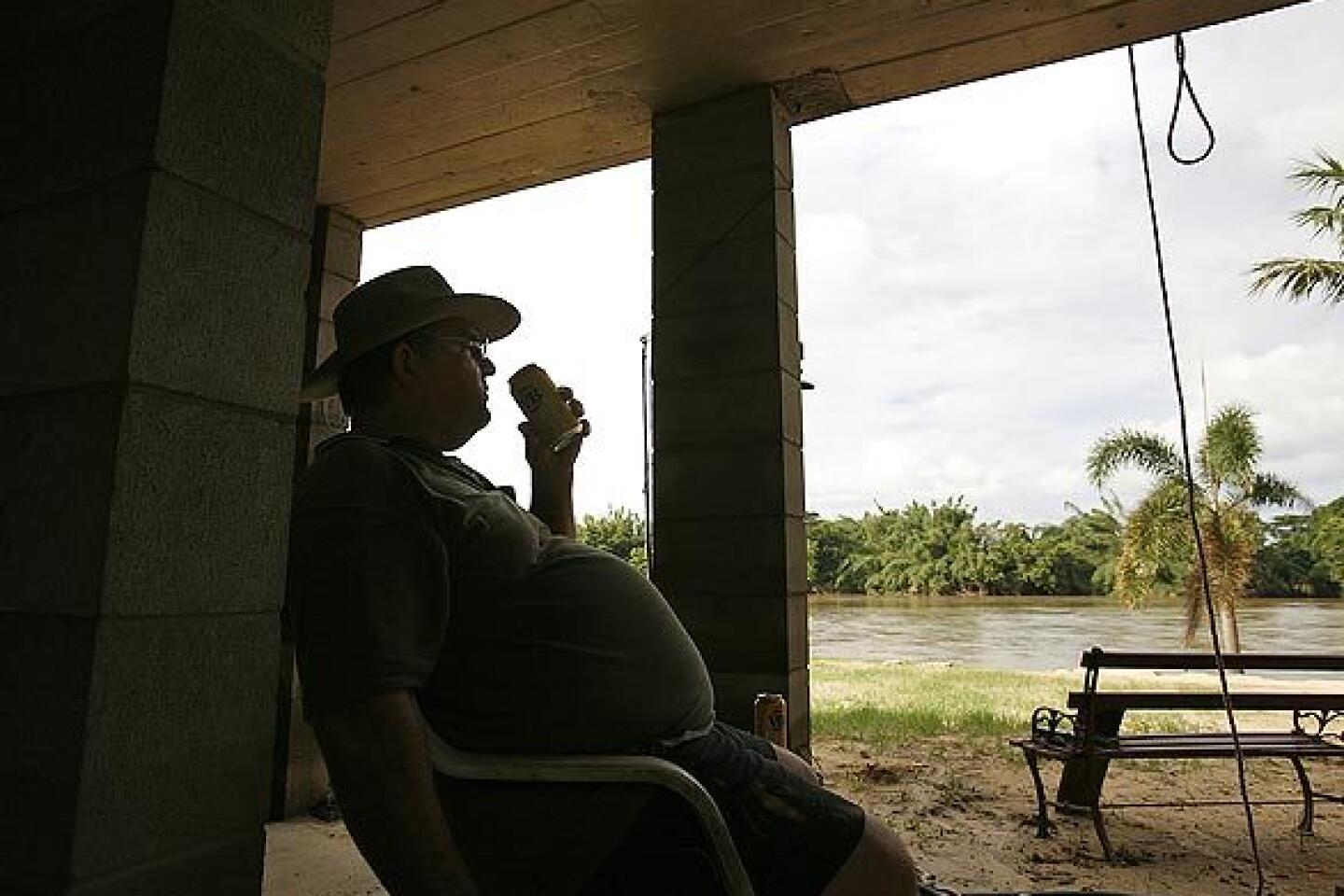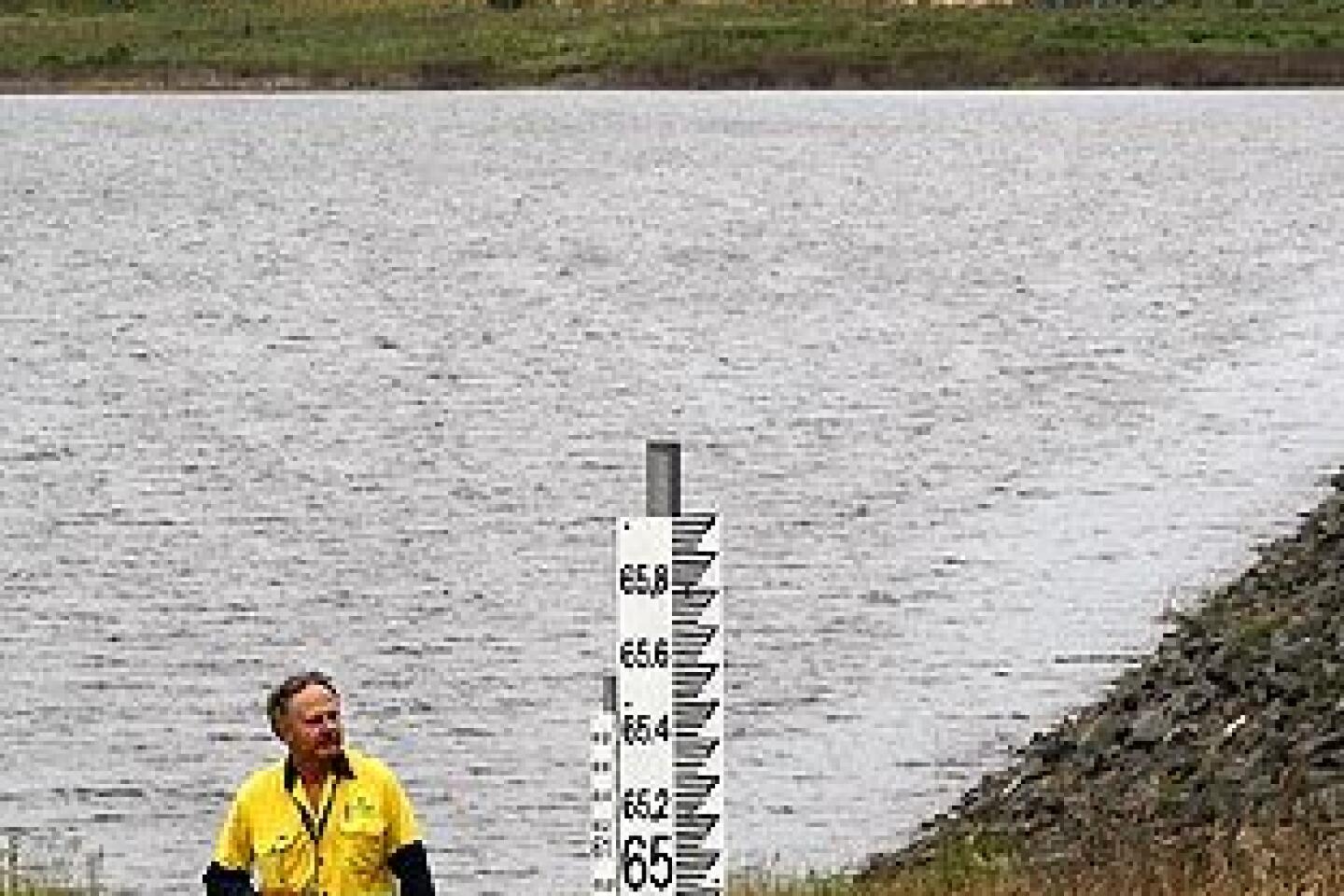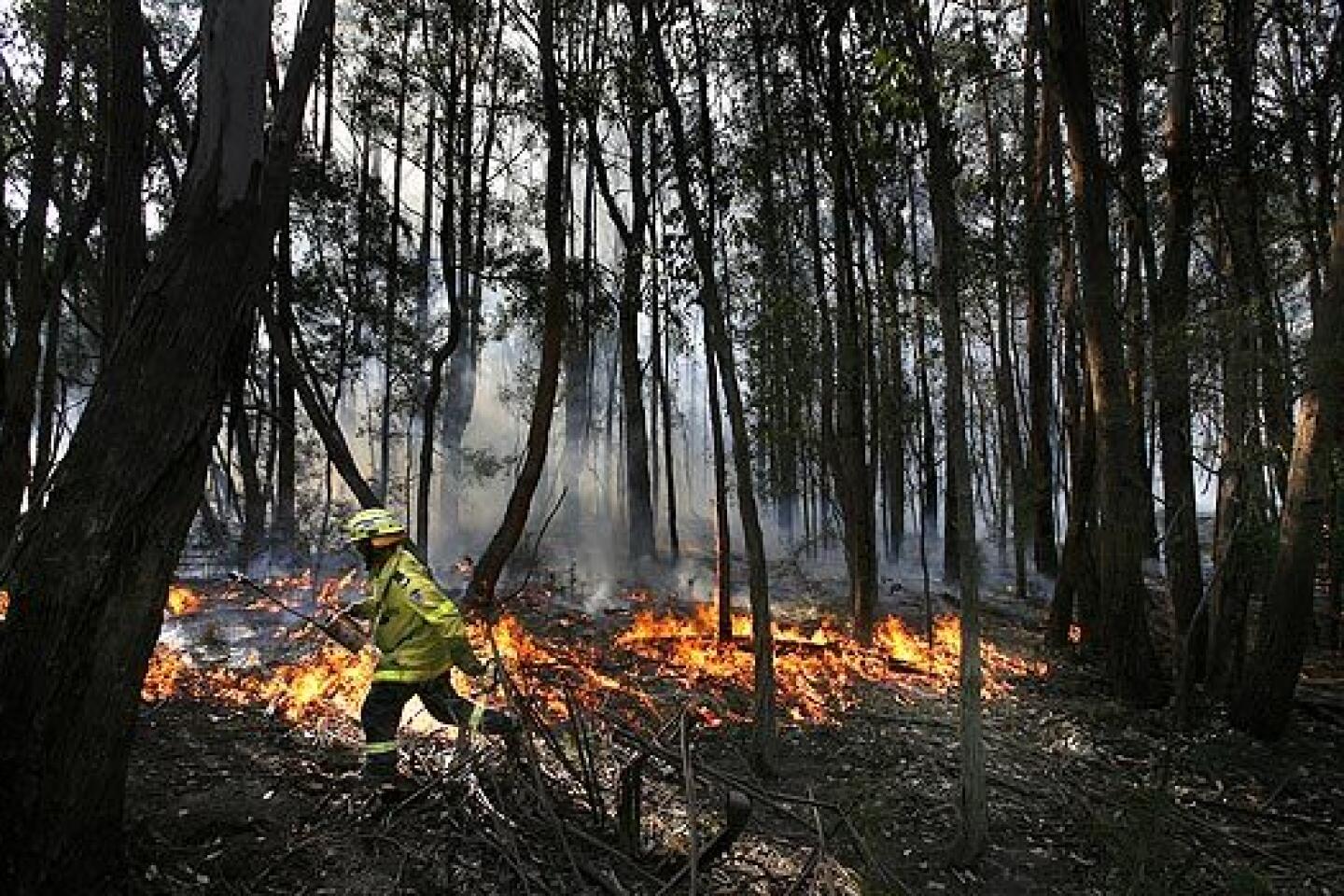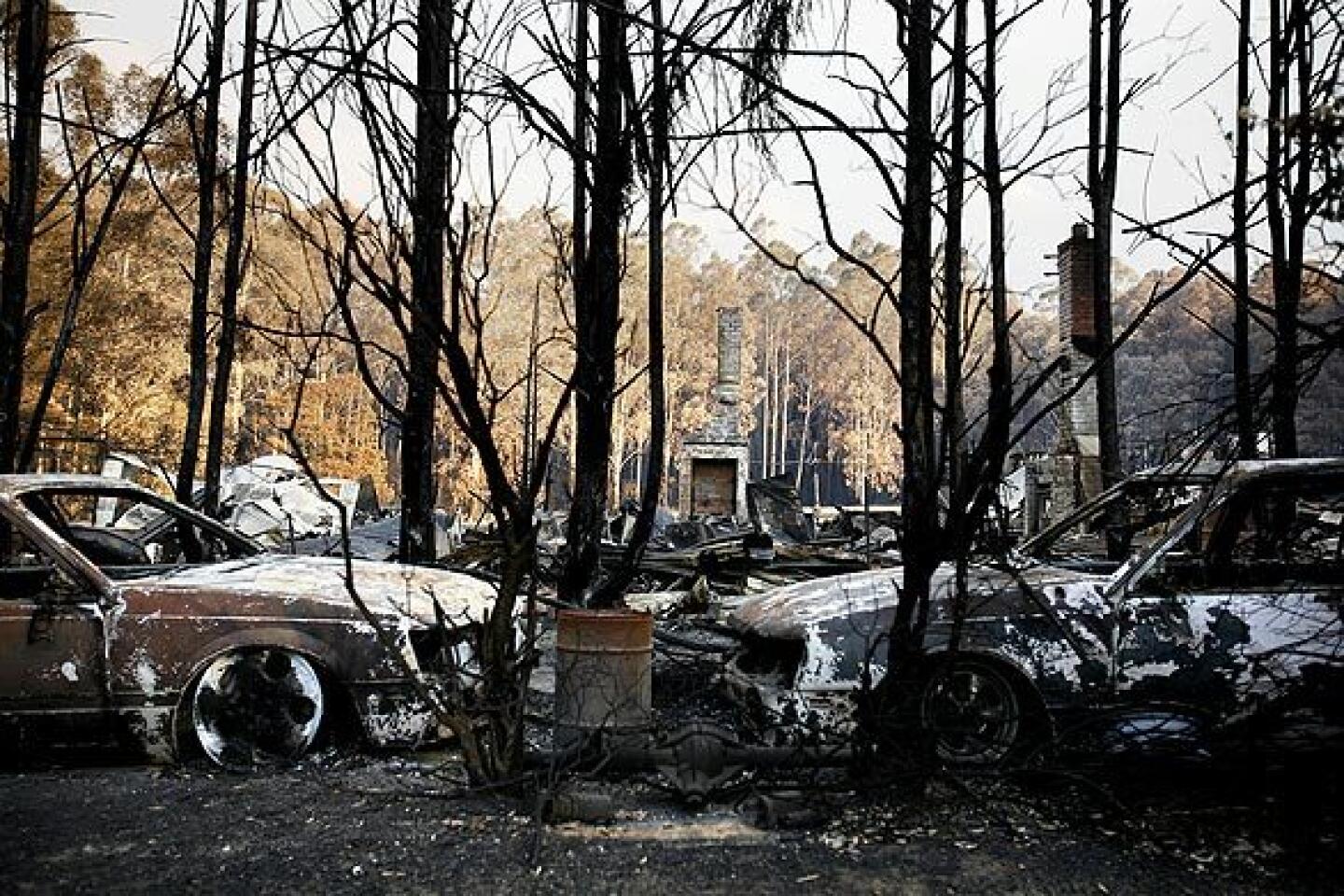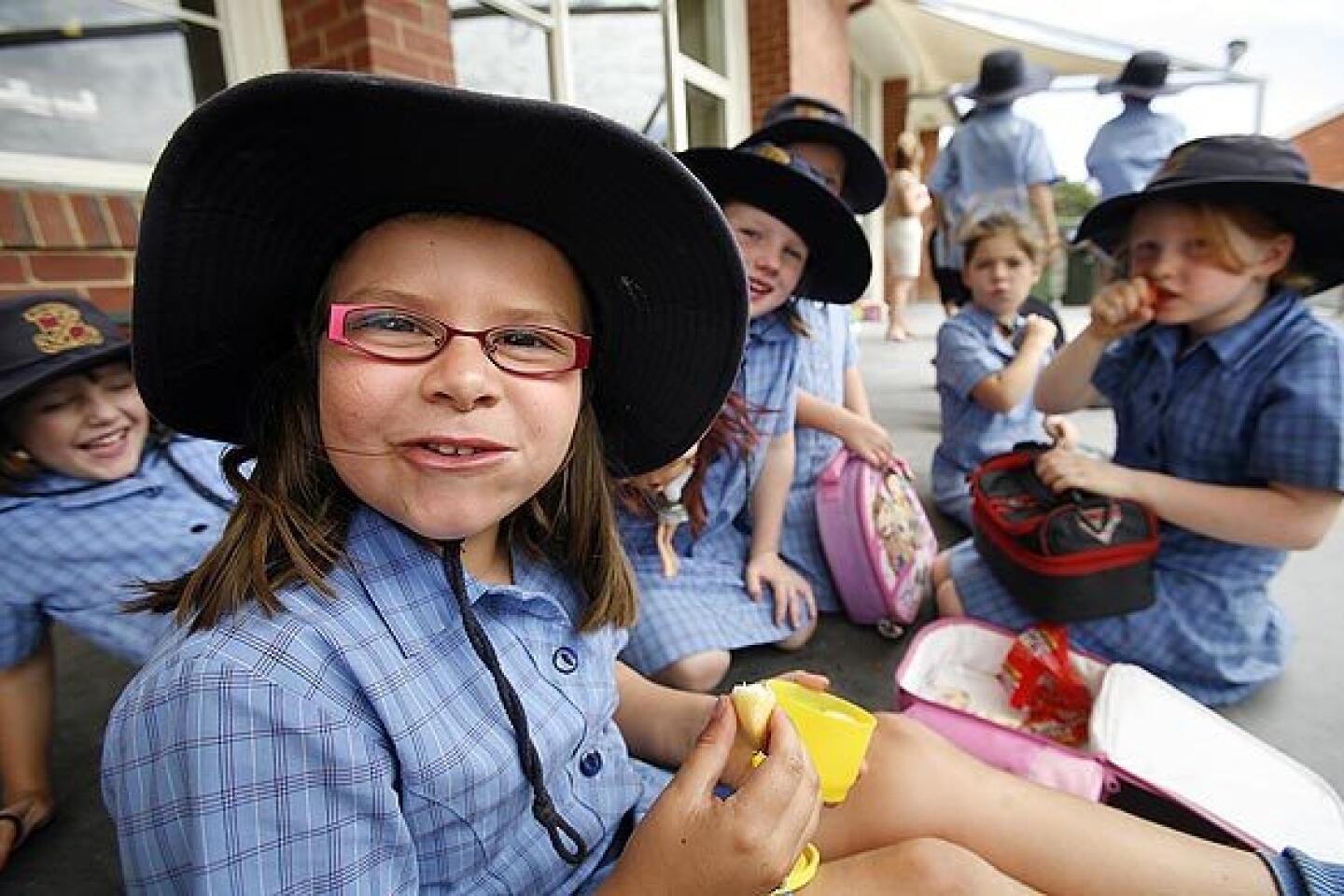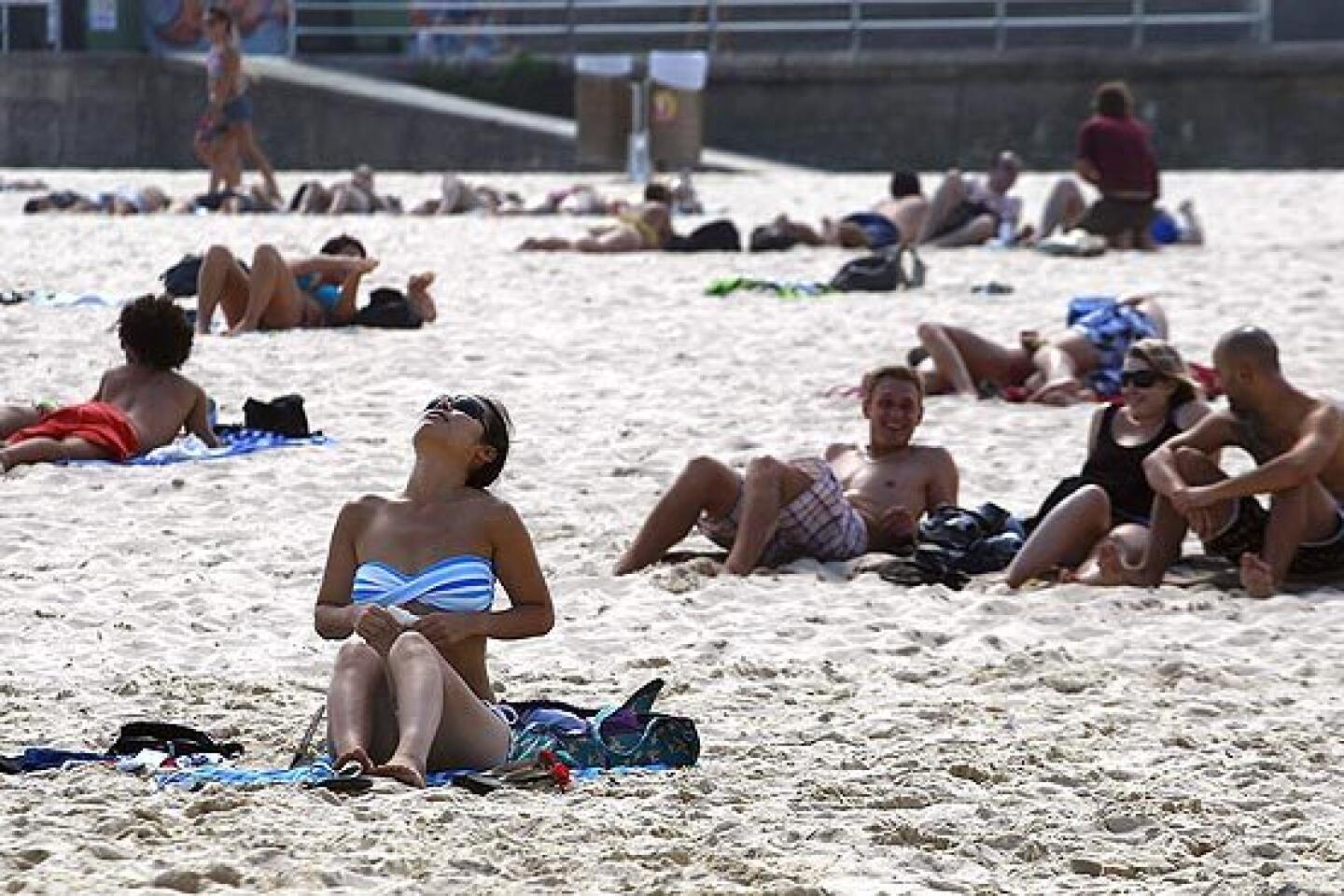What will global warming look like? Scientists point to Australia
- Share via
Reporting from The Murray-Darling Basin, Australia — Frank Eddy pulled off his dusty boots and slid into a chair, taking his place at the dining room table where most of the critical family issues are hashed out. Spreading hands as dry and cracked as the orchards he tends, the stout man his mates call Tank explained what damage a decade of drought has done .
“Suicide is high. Depression is huge. Families are breaking up. It’s devastation,” he said, shaking his head. “I’ve got a neighbor in terrible trouble. Found him in the paddock, sitting in his [truck], crying his eyes out. Grown men -- big, strong grown men. We’re holding on by the skin of our teeth. It’s desperate times.”
A result of climate change?
“You’d have to have your head in the bloody sand to think otherwise,” Eddy said.
They call Australia the Lucky Country, with good reason. Generations of hardy castoffs tamed the world’s driest inhabited continent, created a robust economy and cultivated an image of irresistibly resilient people who can’t be held down. Australia exports itself as a place of captivating landscapes, brilliant sunshine, glittering beaches and an enviable lifestyle.
Look again. Climate scientists say Australia -- beset by prolonged drought and deadly bush fires in the south, monsoon flooding and mosquito-borne fevers in the north, widespread wildlife decline, economic collapse in agriculture and killer heat waves -- epitomizes the “accelerated climate crisis” that global warming models have forecast.
With few skeptics among them, Australians appear to be coming to an awakening: Adapt to a rapidly shifting climate, and soon. Scientists here warn that the experience of this island continent is an early cautionary tale for the rest of the world.
“Australia is the harbinger of change,” said paleontologist Tim Flannery, Australia’s most vocal climate change prophet. “The problems for us are going to be greater. The cost to Australia from climate change is going to be greater than for any developed country. We are already starting to see it. It’s tearing apart the life-support system that gives us this world.”
Deadly fires
Many here believe Australia already has a death toll directly connected to climate change: the 173 people who died in February during the nation’s worst-ever wildfires, and 200 more who died from heat the week before. A three-person royal commission has convened to decide, among other things, whether global warming contributed to massive bush fires that destroyed entire towns and killed a quarter of Victoria state’s koalas, kangaroos, birds and other wildlife.
The commission’s proceedings mark the first time anywhere that climate change could be put on trial. And it will take place in a nation that still gets 80% of its energy from burning coal, the globe’s largest single source of greenhouse gases.
The commission’s findings aren’t due until August, but veteran firefighters, scientists and residents believe the case has already been made. Even before the flames, 200 Melbourne residents died in a heat wave that buckled the steel skeleton on a newly constructed 400-foot Ferris wheel and warped train tracks like spaghetti. Cities experienced four days of temperatures at 110 degrees or higher with little humidity, and 100-mph winds. In areas where fires hit, temperatures reached 120.
On the hottest day, more than 4,000 gray-headed flying foxes dropped dead out of trees in one Melbourne park.
“Something is happening in Australia,” firefighter Dan Condon of the Melbourne Metropolitan Fire Brigade wrote in an open letter. “Global warming is no longer some future event that we don’t have to worry about for decades. What we have seen in the past two weeks moves Australia’s exposure to global warming to emergency status.”
The possibility that a high-profile royal commission may find a nexus between climate change and the loss of human life is significant for many scientists here.
“That will be an important moment in its own right,” said Chris Cocklin, a climate change researcher at James Cook University in Townsville, in Queensland state, and lead author on the latest report from the Intergovernmental Panel on Climate Change.
“It may mean that climate change will be brought to the fore in a way that has never happened before.”
Dust Bowl scenes
Australia’s climate change predicament is on depressing display in the Murray-Darling Basin, where the country’s three largest rivers converge, and where Eddy runs a shrinking 100-acre orchard.
The rivers -- the Murray, Darling and Murrumbidgee -- flow from the western slopes of the Great Dividing Range and nourish the valleys of Australia’s fruit and grain basket, as well as a diverse system of wetlands, grasslands and eucalyptus forests.
Like scenes from a modern Dust Bowl, mile after mile of desiccated fields lie fallow, rows of shriveled trees that once bore peaches and pears are now abandoned orchards, and small businesses are shuttered, fronted by for-sale signs. The dingy brown of the landscape rearranges in a cloud of dust with every hot wind that blows.
Farmers who once grew 60% of the nation’s produce are walking off their land or selling their water rights to the state and federal government. With rainfall in the region at lower than 50% of average for more than a decade, Australia is witnessing the collapse of its agricultural sector and the nation’s ability to feed itself.
In rural Victoria, one rancher or farmer a week takes his own life. Public health officials say hanging is the preferred method.
“Fourteen dairy farmers in the valley have committed suicide in the last five years,” Eddy said matter-of-factly, staring at his hands at his long, wooden dining room table. “Hangings, they are common but they are not made public. It’s really depressing, it’s really tough going.
“Fruit growers are abandoning their orchards. It’s their life’s work, and it’s gone to dust. They are at their wits’ end. The small growers haven’t got the money to replant. Haven’t got the time to wait five years for a return. The machinery they have is not salable. They have thrown their arms up and walked away. They are broken people.”
Pulling up trees
Those who remain continue bulldozing apple and peach trees too stressed to produce marketable fruit. Each fall, orchard owners burn the trees in a massive bonfire, forlornly “toasting” their failed crops with cans of beer. More than 20% of the fruit trees in the Goulburn Valley have been pulled up in recent years. Few new trees take their place.
Local dairy farmers live a similar definition of unsustainability, concluding they can make more money selling their water to cities than they can selling milk.
“That’s what got us through last year,” said Di Davies, Eddy’s neighbor. “We parked our cows and sold our water.”
Santo Varapodio, 73, is the patriarch of a family that runs one of the largest fruit operations around the nearby agricultural center of Shepparton. The area’s annual rainfall used to be 19 to 21 inches a year.
“Now we’re lucky if we get 6 to 7 inches,” Varapodio said, displaying the stunted pears picked from under-watered trees. He said this summer’s heat wave “cooked” his fruit. “When we bring the pears in, about 15% will have burn on them,” Varapodio said. “The apples will have anything up to 50% sunburn on them.”
Rainfall patterns have been frustratingly uncooperative. Gentle winter showers that replenished groundwater have been replaced by torrential summer onslaughts that turn the fertile topsoil into a slough.
Most of the country is in the grip of the worst drought in more than a century. Every capital in Australia’s eight states and territories is operating under considerable water restrictions. In urban areas, “bucketing” has become a common practice -- placing pails in showers and using the gray water on lawns or gardens. In some cities, such as Brisbane, residents drink recycled water, a process nicknamed “toilet to tap.”
In rural areas, the lucky tap their own wells, provided they still function. Others survive on rainwater or what they can scrounge or buy.
Meanwhile, the tropical north’s rainy season, known as the Big Wet, is longer and wetter than ever. Warming tropical waters in the Coral Sea and the Gulf of Carpentaria spawn ever more powerful cyclones, while rainfall and heat records are broken every year.
The coastal city of Darwin, in the Northern Territory, swelters through 20 to 30 days of temperatures above 95 degrees, with high tropical humidity. Government scientists project that by 2070, Darwin will experience such conditions as many as 300 days a year.
Communities on the Cape York Peninsula accustomed to being flooded for days are commonly cut off for weeks. Throughout February, the Queensland government airdropped supplies to citizens, who had to wait to reemerge when the water recedes in the Southern Hemisphere’s autumn, in late March or early April. In the meantime, in-ground burials are on hold.
Climate change researcher Cocklin lives in the far north, where the new regime of intensified monsoons scarcely gives Queenslanders a break.
“You might get punched and get up again,” he said. “The second time it’s harder to get up. The third time, you can’t be bothered. How many times can you get punched?”
Australians in the south would see water as heaven-sent; in the north, it’s a curse. In March, a young girl playing by a rain-swollen river was carried off by a crocodile, the second child lost to crocs in a month.
The region is beset with twin epidemics of malaria and a dangerous form of hemorrhagic dengue fever, from mosquitoes that breed in the standing water. Such diseases are expected to become more common in the tropics with climate change.
Reef is withering
Not far from where Cocklin lives, the north’s two largest tourism draws, the Great Barrier Reef and the Tropical Rainforest Reserve, are withering under climate extremes. Higher ocean temperatures are bleaching expanses of coral and affecting fish and plant species. A report issued last year by the Intergovernmental Panel on Climate Change projected that the Great Barrier Reef will be “functionally extinct” by 2050.
Cocklin was just back from giving a presentation at a climate change conference in Europe, showing the degradation of the reef as well as photographs of the bush fires and floods. “The audience was a little bit in awe of what’s going on in Australia,” he said.
Inland, tropical forests are retreating up mountainsides as species of towering trees die off at lower altitudes and reestablish themselves in cooler climes. Rare and unique animals are on the move, competing for scant space atop Australia’s modest topography. In most areas, the vertical distance from the tree line to a mountain’s peak is less than a quarter-mile.
“If you are at the top of the mountain, it will only take a couple of degrees to push you off the top,” said Stephen Williams, director of the Center for Tropical Biodiversity and Climate Change in Townsville. Scientists paint a bleak picture of wildlife competing for space on peaks in the country’s alpine region. Williams and other biologists predict as much as 50% animal extinction in the region by the end of the century.
Chief among the candidates for extinction is the rare white lemuroid ringtail possum, a singular species that Flannery, the paleontologist, describes as “our panda.” The pale creatures live high in trees in the 4,000 square miles of moist forest in northeast Queensland. They can’t tolerate, even for hours, temperatures above 86 degrees. Williams’ research found that the possum was gone in one of the animal’s two historical ranges, and in the other it “has declined dramatically, to the point where you can barely detect it.”
Williams said that when he shares his research illustrating the degree to which the continent’s biodiversity is at risk, “people’s jaws drop.”
Scientists are frustrated that such dramatic anecdotal and empirical evidence hasn’t sparked equally dramatic action from Australia’s government. They suspect the inaction can be partly explained by examining the nation’s relationship with coal. Australia is the world’s largest exporter of coal and relies on it for 80% of its electricity. That helps make Australia and its 21 million people the world’s highest per-capita producers of greenhouse gases in the industrialized world.
Climate change researcher Cocklin, who is deputy vice chancellor at James Cook University, said the power of the coal companies and the massive receipts they bring in render the industry politically untouchable.
“The nature of our energy profile is one where coal features significantly,” he said. “There’s no denying it’s a massive problem. I don’t think in the public-political arena it is being challenged with the tenacity that you would want. No Labor [Party] government is going to challenge that.”
Prime Minister Kevin Rudd says climate change is high on his agenda, but many here are disappointed by his pledge to cut overall greenhouse gas emissions by only 5% by 2020.
Scientists and policymakers now agree that even drastic cuts won’t halt climate changes already underway. In response, some Australians are considering whether outback settlements should be abandoned.
“We are already very flat and very dry as a continent,” Flannery said. “There is just this little margin that is inhabitable. We don’t have a lot of options.”
Most Australians live on the coast, where they are vulnerable to flooding because of rising sea levels, projected to increase by 6 1/2 feet this century.
“Some places are pretty close to being bloody unlivable anymore,” Cocklin said.
“When you start talking about places where 45 degrees [113 Fahrenheit] is commonplace, that raises the question of ‘Can you really live in that?’ ”
More to Read
Sign up for Essential California
The most important California stories and recommendations in your inbox every morning.
You may occasionally receive promotional content from the Los Angeles Times.
